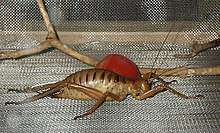Giant weta
| Giant weta | |
|---|---|
 | |
| Poor Knights Islands giant weta (Deinacrida fallai) – overall length 20 cm (8 inches) | |
| Scientific classification | |
| Kingdom: | Animalia |
| Clade: | Euarthropoda |
| Class: | Insecta |
| Order: | Orthoptera |
| Suborder: | Ensifera |
| Family: | Anostostomatidae |
| Subfamily: | Deinacridinae |
| Genus: | Deinacrida White, 1842 |
| Species | |
|
See text | |
Giant weta are several species of weta in the genus Deinacrida of the family Anostostomatidae. Giant weta are endemic to New Zealand and are examples of island gigantism.
There are eleven species of giant weta[1], most of which are larger than other weta, despite the latter also being large by insect standards. Large species can be up to 10 cm (4 in), not inclusive of legs and antennae, with body mass usually no more than 35 g. One captive female reached a mass of about 70 g (2.5 oz.), making it one of the heaviest documented insects in the world[2] and heavier than a sparrow. This is, however, abnormal, as this individual was unmated and retained an abnormal number of eggs. The largest species of giant weta is the Little Barrier Island giant weta,[3] also known as the wetapunga. One example reported in 2011 weighed 71 g.[4]
Giant weta tend to be less social and more passive than other weta. Their genus name, Deinacrida, means "terrible grasshopper", from the Greek word δεινός (deinos, meaning "terrible", "potent", or "fearfully great"), in the same way dinosaur means "terrible lizard". They are found primarily on New Zealand offshore islands, having been almost exterminated on the mainland islands by introduced mammalian pests.
Habitat & Distribution
Most populations of giant weta have been in decline since humans began modifying the New Zealand environment. All but one giant weta species is protected by law because they are considered at risk of extinction[5]. Three arboreal giant weta species are found in the north of New Zealand and now restricted to mammal-free habitats. Deinacrida heteracantha, and D. fallai are found only on near-shore islands that have no introduced predators (Te Haututu-o-Toi and Poor Knights Island). The closely related species D. mahoenui is restricted to habitat fragments in North Island.[6]
Two closely related giant weta species are less arboreal. Deinacrida rugosa is restricted to mammal-free reserves and D. parva is found near Kaikoura in South Island New Zealand.
Many giant weta species are alpine specialists. Five species are only found at high elevation in South Island. The scree weta D. connectens lives about ~1200 m asl[7] and freezes solid when temperatures drop below -5°C.[8]
Species list
- Deinacrida carinata, Herekopare weta
- Deinacrida connectens, Scree weta
- Deinacrida elegans, Bluff weta
- Deinacrida fallai, Poor Knights giant weta
- Deinacrida heteracantha, Little Barrier Island giant weta
- Deinacrida mahoenui, Mahoenui giant weta
- Deinacrida parva, Kaikoura giant weta
- Deinacrida pluvialis, Mt Cook giant weta
- Deinacrida rugosa, Cook Strait giant weta
- Deinacrida talpa, Giant mole weta
- Deinacrida tibiospina, Mt Arthur giant weta
References
- ↑ Morgan-Richards, M (2001). "A phylogenetic analysis of New Zealand giant and tree weta (Orthoptera : Anostostomatidae : Deinacrida and Hemideina) using morphological and genetic characters". Invertebrate Taxonomy. 15: 1–12.
- ↑ "Book of Insect Records".
- ↑ Jessica Satherley (2011-12-01). "Meet the world's heaviest insect, which weighs three times more than a mouse... and eats carrots". The Daily Mail.
- ↑ "World's biggest insect is so huge it eats carrots". Telegraph. 2011-12-01. Retrieved 2012-08-26.
- ↑ Trewick, S (2012). "The conservation status of New Zealand Orthoptera". New Zealand Entomologist. 35: 131–136.
- ↑ Field, L (2001). The Biology of wetas, king crickets and their allies. UK: CABI. ISBN 0851994083.
- ↑ Morgan-Richards, M (1996). "Colour, allozyme and karyotype variation in the New Zealand Giant Scree Weta Deinacrida connectens (Orthoptera: Stenopelmatidae)". Hereditas. 125: 265–276.
- ↑ Sinclair, B (1999). "Insect cold tolerance: How many kinds of frozen?". European Journal of Entomology. 96: 157–164.
External links
| Wikispecies has information related to Deinacrida |
| Wikimedia Commons has media related to Deinacrida. |